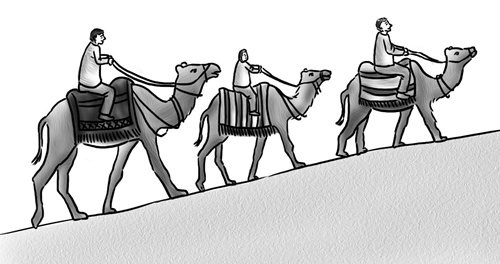
Illustration: Xia Qing/GT
This year is the 40th anniversary of China's reform and opening-up. When this process started in late 1978, China was one of the poorest countries in the world. From that low starting point, China has achieved an average 9.5 percent annual GDP growth rate. No any other country or region in human history has kept up such a high speed of economic growth for such a long time.
The nation's trade grew even faster during this period, rising by an average of 14.5 percent annually.
In the 1980s and 1990s, almost all developing countries pursued reform and opening-up. But most of their economies ended up encountering stagnation, crises and even collapses. In contrast, despite having its own problems, China has grown at a steady and fast pace.
China did encounter many problems in this reform and opening-up process. Every time there is sign of an economic slowdown, there are those who contend that the Chinese economy will collapse soon. However, looking back, China is the only country in the past 40 years to have gone without experiencing an economic crisis.
The reason is that the reform of China was tailored to Chinese realities and conditions, instead of blindly following Western theories and rules. At the start of reform, China had a large number of State-owned enterprises with low efficiency that couldn't survive without subsidies. The nation's policies provided protection and subsidies for them to transform.
At the same time, the country opened up access for labor-intensive industries. China also built industrial parks, export zones and special economic zones to bring in capital, turning its comparative advantages to competitive advantages.
The new industries developed at a rapid pace and built up capital. The nation's comparative advantage was thus upgraded from labor to capital, which then provided the necessary conditions for the transformation of obsolete industries. That is why China could maintain stability and fast development in the past 40 years.
But why did other developing countries' reform and opening-up efforts encounter problems?
I have tried to build a new theoretical framework, which I would call new structural economics, that summarizes the successes and failures of those developing countries.
The bottleneck for any developing country is lack of infrastructure. If the necessary infrastructure is missing, there is no way to adopt modern technology and industry to promote productivity. Official development assistance (ODA) is mainly used by developing countries in the areas of political governance, political transparency, human rights, gender equality, education and healthcare, but not in infrastructure.
The providers of ODA have good intentions, but the money can't eliminate the bottleneck in many developing countries.
Based on China's experience, an upgraded infrastructure is the basic premise for a developing country to start the modernization process. This is exactly why infrastructure connectivity serves as the basis of the whole Belt and Road initiative (BRI). The BRI has been quite compelling since it was proposed as an international aid to development.
China would like to provide funding support to countries along the routes of the BRI, but addressing the huge infrastructure gaps cannot be funded alone by China. A multilateral solution will have to be generated to mobilize the capital. That's why the Asian Infrastructure Investment Bank (AIIB) was proposed by China. Countries and regions are actively joining, and the AIIB has become a multilateral international financing organization that has the largest number of members aside from the World Bank.
The importance of infrastructure construction is not only realized by China but also by the US. In 2011, the US proposed connecting five Central Asian countries with Afghanistan via infrastructure that would provide a path to the Indian Ocean. It also proposed the India-Pacific economic corridor in the same year, which would link the Indian Ocean with the Pacific Ocean.
These initiatives were similar to the BRI, but they drew scant response from the international community. However, the China-proposed BRI has been well accepted. Why is there so much difference? China has more advantages in terms of infrastructure construction.
First, China is capable when it comes to building infrastructure projects. China accounts for up to 50 percent of the global production of steel and concrete. Since the start of reform and opening-up, China's fast-developing infrastructure has led to the formation of cost-effective construction teams. The US, on the other hand, passed its peak on the infrastructure front following its massive highway construction after World War II.
Second, infrastructure needs funding. China has abundant foreign reserves, which have been used to buy US bonds or stocks. The return rate is low and the risk is high. If this money is invested in BRI-related infrastructure, the return rate will be higher as long as the projects are well-chosen. Chinese commercial banks have several hundred billion dollar surpluses on the current account every year. So, China has advantages in funding.
Third, whether the infrastructure will bring prosperity depends on industrial development. The time must be right. A small number of developing countries that succeeded in their transformation efforts had something in common: they took advantage of demand for labor-intensive work and made an industrial shift.
Fourth, developing countries pursued their industrialization and modernization guided by the theories and experience of developed countries. But developing and developed countries face different situations. The theories and experience that worked for developed countries were very situational. China has had similar conditions to those of other developing countries. Borrowing China's experience is a more feasible choice.
China's development can offer opportunities for mutual prosperity to other developing countries. The BRI will make the grand vision of a community with a shared future come true.
The article was compiled based on a speech by Justin Lin Yifu, co-founder of the National School of Development at Peking University and former chief economist of the World Bank, at a seminar on September 26 at Beijing Normal University. bizopinion@globaltimes.com.cn




